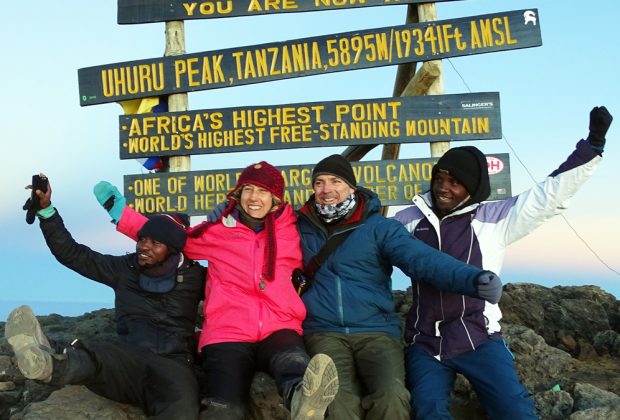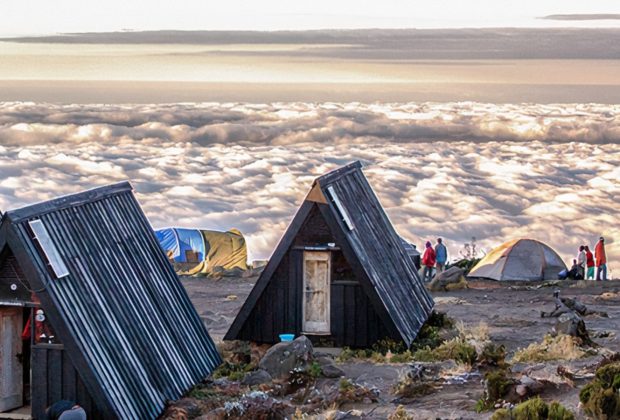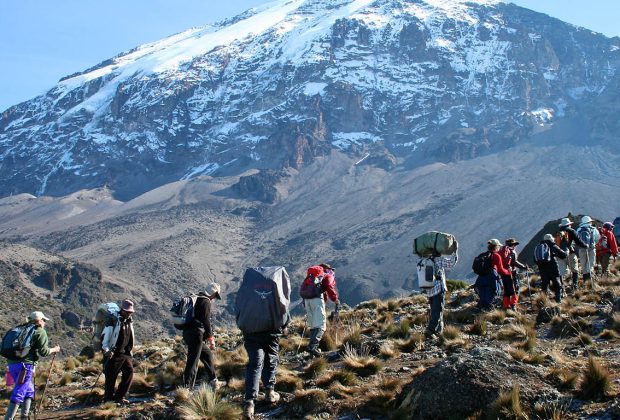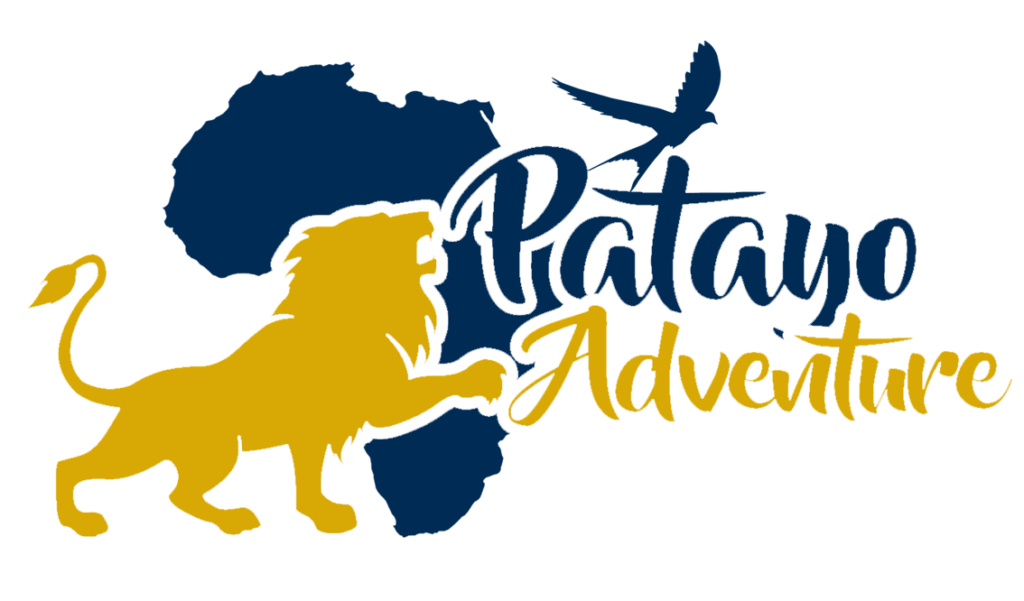7-Day Kilimanjaro Trekking Via Machame Route + 2 Nights Hotel Stay
Tour Overview
The Machame route, also known as the “Whiskey Route,” is the second most popular choice among climbers on Kilimanjaro. It offers a diverse range of perspectives, landscapes, and experiences. Starting from Machame Gate, just a short 20-minute drive from Aishi Machame Hotel, this route leads climbers to the summit of Kilimanjaro along a spectacular trail. Beginning in the tropical forest, the route traverses through all the climatic zones, culminating in the Arctic desert at the summit.
Camps along the Machame route are strategically located for optimal acclimatization, ensuring a smooth and gradual adjustment to the altitude. On the third day of the trek, the Machame Route intersects with the Lemosho and Umbwe routes at Barranco camp. Climbers have the option to choose between a six or seven-day climb, with the latter being preferred for better acclimatization progress.



Day 1 | Arrival at Kilimanjaro International Airport
Upon your arrival at Kilimanjaro International Airport (JRO), you’ll be warmly welcomed by a representative from Kiliholidays. They will assist you with your transfer to Weru Weru River Lodge (https://www.weruweruriverlodge.com/), where you’ll find all the essentials for a comfortable stay. Take some time to settle in and relax before an evening briefing with Kiliholidays managers to ensure you’re fully prepared for the upcoming climb. Note: Check-in at the lodge begins at 1:00 PM.
Day 2 | Transfer to Machame Gate and Trek to Machame Camp
After breakfast at Weru Weru River Lodge, meet your guide and the mountain support crew who will accompany you throughout the climb. Travel by vehicle to Kilimanjaro National Park’s entrance at Machame Gate (1,800 m). Upon completing the necessary formalities and acquiring climbing permits, embark on the trek to Machame Camp (3,010 m). The trail leads through the lush rainforest, where you may encounter tropical showers. Arrive at Machame Camp and settle in for the night.
Day 3 | Trek from Machame Camp to Shira Camp
Start the day with a hearty breakfast at Machame Camp before continuing your ascent. Trek from Machame Camp to Shira Camp (3,845 m), leaving the rainforest behind and enjoying panoramic views of the Shira Plateau along the way. Take breaks as needed to acclimatize to the altitude. Optionally, embark on an acclimatization hike towards Lava Tower Camp, gaining an additional 300 meters in altitude before returning to Shira Camp for dinner and overnight stay.
Day 4 | Trek from Shira Camp to Barranco Camp via Lava Tower
After breakfast at Shira Camp, begin your trek towards Barranco Camp, passing through the iconic Lava Tower along the way. Ascend from 3,845 m to 4,630 m to reach Lava Tower, a crucial point for acclimatization. Enjoy lunch at Lava Tower before descending to Barranco Camp (3,960 m) for the night. Marvel at the impressive Barranco Wall and prepare for the next day’s climb.
Day 5 | Trek from Barranco Camp to Karanga Camp
Today’s trek takes you from Barranco Camp to Karanga Camp (4,035 m). Begin with a climb up the Barranco Wall, a thrilling but manageable ascent. Take in the breathtaking views from the top before descending to Karanga Camp for lunch. In the afternoon, embark on an acclimatization hike towards Barafu Camp, reaching an altitude of 4,270 m, before returning to Karanga Camp for dinner and overnight stay.
Day 6 | Trek from Karanga Camp to Barafu Camp
After breakfast at Karanga Camp, continue your ascent towards Barafu Camp (4,640 m), your base for the final push to the summit. The trek offers stunning views as you traverse the alpine desert landscape. Upon reaching Barafu Camp, rest and refuel before an optional acclimatization hike towards Kosovo Camp (4,800 m). Return to Barafu Camp for dinner and a well-deserved rest ahead of the summit attempt.
Day 7 | Summit Day: Barafu Camp to Uhuru Peak and Descent to Millennium Camp
Rise before midnight for the summit attempt, departing Barafu Camp in the early hours. Trek through the night to reach Uhuru Peak (5,895 m), the highest point in Africa, in time to witness the sunrise. Take in the awe-inspiring views from the summit before beginning the descent back to Barafu Camp. After a brief rest, continue descending to Millennium Camp (3,820 m) for the night, celebrating your accomplishment and reflecting on your journey.
Day 8 | Descent to Mweka Gate and Transfer to Hotel
On the final day of your Kilimanjaro adventure, wake up at Millennium Camp and enjoy a hearty breakfast. Begin your descent through the lush rainforest, following the trail to Mweka Gate (1,650 m). Descend slowly, taking in the sights and sounds of the forest as you make your way down. Upon reaching Mweka Gate, bid farewell to your mountain crew and collect your summit certificates as a memento of your achievement.
After completing the necessary formalities at the gate, you’ll be transferred back to Weru Weru River Lodge or similar hotel for a well-deserved rest. Spend the afternoon relaxing and reflecting on your incredible journey to the roof of Africa. Enjoy a delicious dinner at the lodge and share stories of your climb with fellow trekkers.
Inclusions:
- Accommodation: Lodging at Weru Weru River Lodge or similar.
- Meals: Breakfast, lunch, and dinner provided during the trek.
- Transportation: Transfer from Kilimanjaro International Airport to the lodge.
- Trekking Support: Experienced guide and mountain support crew.
- Climbing Permits: Acquisition of necessary permits for Kilimanjaro National Park.
- Equipment: Tents, sleeping bags, and other necessary camping gear.
- Activities: Trekking from Marangu Gate to Mandara Hut, Mandara Hut to Horombo Hut, Horombo Hut to Kibo Hut, and summiting Uhuru Peak.
- Briefings: Orientation and briefing sessions conducted by tour managers.
- Safety Measures: Registration with search and rescue service, as well as guidance on altitude sickness prevention.
- Certificates: Commemorative certificates upon successful completion of the trek.
Exclusions:
- International Flights: Airfare to and from Kilimanjaro International Airport.
- Travel Insurance: Personal travel insurance covering medical expenses, trip cancellations, and emergencies.
- Personal Expenses: Expenses for additional meals, beverages, souvenirs, and optional activities.
- Gratuities: Tips for guides, porters, and other staff members.
- Accommodation Beyond Itinerary: Any additional lodging required before or after the scheduled trekking dates.
- Airport Transfers: Transfers to the airport upon departure beyond the designated schedule.
- Visa Fees: Fees associated with obtaining entry visas for Tanzania, if applicable.
- Medical Expenses: Costs incurred for medical treatment or medications during the trek.
- Optional Activities: Any additional excursions or activities not specified in the itinerary.
What is Mount Kilimanjaro?
- Mount Kilimanjaro is the highest peak in Africa, located in Tanzania. It is a dormant volcano and one of the most iconic mountains in the world.
How tall is Mount Kilimanjaro?
- The summit of Mount Kilimanjaro, called Uhuru Peak, stands at an elevation of 5,895 meters (19,341 feet) above sea level.
How long does it take to climb Mount Kilimanjaro?
- The duration of a Kilimanjaro climb varies depending on the route chosen. Most climbs typically range from 5 to 9 days.
What are the different routes up Mount Kilimanjaro?
- There are several routes to the summit of Kilimanjaro, each with its own characteristics and scenery. Popular routes include the Marangu, Machame, Lemosho, Rongai, and Northern Circuit routes.
Is climbing Mount Kilimanjaro difficult?
- Climbing Kilimanjaro is challenging due to its high altitude, but it doesn’t require technical climbing skills. However, climbers should be physically fit and prepared for the rigors of high-altitude trekking.
Do I need a guide to climb Mount Kilimanjaro?
- Yes, it is mandatory to have a registered guide accompany you on your Kilimanjaro climb. Guides are essential for safety, navigation, and providing support throughout the trek.
When is the best time to climb Mount Kilimanjaro?
- The best times for climbing Kilimanjaro are during the dry seasons, which are typically from late June to October and from December to March. These months offer clearer skies and better trekking conditions.
What should I pack for climbing Mount Kilimanjaro?
- Essential items for climbing Kilimanjaro include proper clothing for varying temperatures, sturdy hiking boots, a good quality sleeping bag, trekking poles, personal medications, and other necessary gear as recommended by your tour operator.
What are the risks of climbing Mount Kilimanjaro?
- The main risks of climbing Kilimanjaro include altitude sickness, which can affect anyone regardless of fitness level, as well as other potential hazards such as extreme weather conditions and physical exhaustion.
Do I need to train before climbing Mount Kilimanjaro?
- Yes, it is highly recommended to undergo physical training and preparation before attempting to climb Kilimanjaro. This can include cardiovascular exercises, strength training, and hiking to build endurance and fitness levels.
